
Zero Wing is a 1989 side-scrolling shooter arcade video game developed by Toaplan and originally published in Japan by Namco and in North America by Williams Electronics. Controlling the ZIG space fighter craft, players assume the role of protagonist Trent in a last-ditch effort to overthrow the alien cyborg CATS. It was the eighth shoot 'em up game from Toaplan, and their fourteenth video game overall.

Darius II is a 1989 arcade shooter video game developed and published by Taito. It is a direct sequel to the 1987 title, Darius. It was later released as Sagaia in Japan in 1991 for the Game Boy as well as non-Japanese ports. A remake was released for the PC Engine Super CD-ROM² as Super Darius II in 1993.

The NewZealand Story is a platform game developed and released in arcades by Taito in 1988. The concept and setting were inspired by a holiday trip in New Zealand by one of the Taito programmers. The player controls Tiki (ティキ), a kiwi who must save his girlfriend Phee Phee (ピューピュー) and several of his other kiwi chick friends who have been kidnapped by a large blue leopard seal. While avoiding enemies, the player has to navigate a scrolling maze-like level, at the end of which they release one of Tiki's kiwi chick friends trapped in a cage. In 2007, the arcade game received a remake for the Nintendo DS under the title New Zealand Story Revolution.

Rainbow Islands: The Story of Bubble Bobble 2 (レインボーアイランド) is a 1987 arcade video game developed and published by Taito, with the arcade version licensed to Romstar for North American manufacturing and distribution. The game is the sequel to Bubble Bobble from the previous year, and it is the second of four arcade games in the series. The game was ported to home computers and home video game consoles.
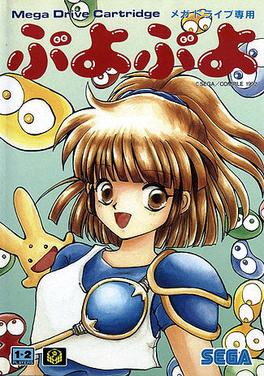
Puyo Puyo (ぷよぷよ) is a puzzle video game released in 1991 by Compile for the MSX2. Since its creation, it uses characters from Madō Monogatari. It was created by Masamitsu "Moo" Niitani, the founder of Compile, who was inspired by certain elements from the Tetris and Dr. Mario series of games.

Chase H.Q. is a vehicular combat racing game, originally released as an arcade video game by Taito in 1988. It is sometimes seen as a spiritual successor to Taito's earlier Full Throttle. The player assumes the role of a police officer named Tony Gibson, member of the "Chase Special Investigation Department". Along with his partner, Raymond Broady, he must stop fleeing criminals in high-speed pursuits in a black Porsche 928.
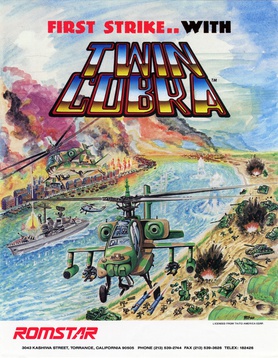
Twin Cobra, known as Kyukyoku Tiger in Japan, is a vertically scrolling shooter developed by Toaplan and released for arcades in 1987 by Taito in Japan and Europe, then in North America by Romstar. It is a sequel to the 1985 arcade game Tiger-Heli. Controlling the titular attack helicopter, the players must fight endless waves of military vehicles while avoiding collision with their projectiles and other obstacles. It was the fourth shoot 'em up game from Toaplan, and their tenth video game overall. It was ported to multiple platforms, with each done by different third-party developers that made several changes or additions.
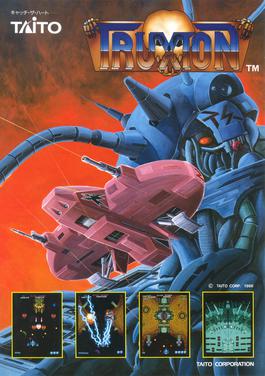
Truxton is a 1988 vertically scrolling shooter arcade video game originally developed by Toaplan and published in Japan and Europe by Taito, as well as in North America by Midway. Set in a future where the Gidans alien race led by Dogurava invaded the fictional planet Borogo, players assume the role of fighter pilot Tatsuo taking control of the Super Fighter ship on a last-ditch effort to overthrow the alien invaders.
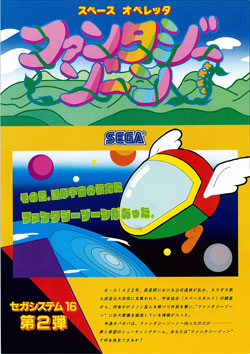
Fantasy Zone is a 1986 arcade video game by Sega, and the first game in the Fantasy Zone series. It was later ported to a wide variety of consoles, including the Master System. The player controls a sentient spaceship named Opa-Opa who fights an enemy invasion in the titular group of planets. The game contains a number of features atypical of the traditional scrolling shooter. The main character, Opa-Opa, is sometimes referred to as Sega's first mascot character.
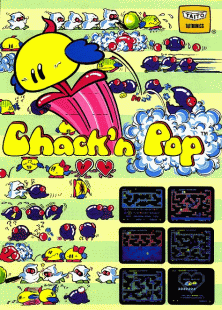
Chack'n Pop is a platform arcade game developed and released by Taito in 1984. In the game, the player controls a small yellow creature, Chack'n, with the objective being to retrieve hearts from a cave, all while avoiding the enemies contained within them. Chack'n also has the ability to deploy bombs, which can kill said enemies, which can bring bonuses depending on if all or none of the enemies have been killed.

RayForce is a vertically scrolling shooter by Taito for the Taito F3 arcade hardware and released in 1994. It was ported to the Sega Saturn in 1995, Microsoft Windows in 1997, then rereleased for iOS in 2012 and Android in 2017.

Special Criminal Investigation, also known as S.C.I. for short or as Chase HQ II: Special Criminal Investigation in some home versions, is vehicular combat racing game published by Taito for arcades in 1989. It is the sequel to the 1988 game Chase H.Q.
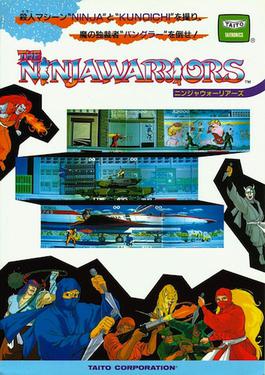
The Ninja Warriors (ニンジャウォーリアーズ) is a side-scrolling beat 'em up video game developed and released by Taito in 1987. The original arcade game situated one display in between projected images of two other displays, creating the appearance of a triple-wide screen. Ports were released for home systems including the Amiga, Atari ST, ZX Spectrum, Commodore 64, Amstrad CPC, PC Engine, and Sega Mega-CD.
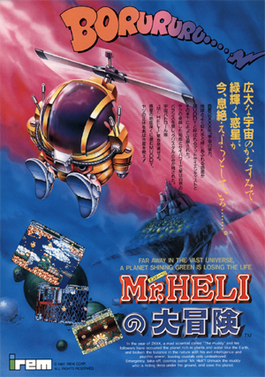
Mr. Heli, fully titled in Japan as Mr. HELI no Daibōken is a multidirectional scrolling shooter developed and published in arcades in 1987 by Irem. It was released in North America as Battle Chopper.
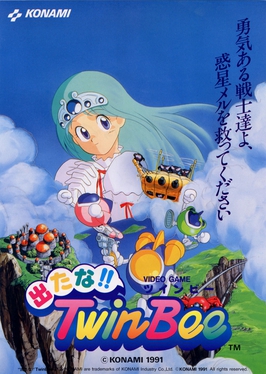
Detana!! TwinBee, released in Europe and North America as Bells & Whistles, is a 1991 vertically scrolling shooter arcade video game developed and released by Konami. It is the fifth entry in the TwinBee series and the second to be released for arcades following the original TwinBee. Set several years after the events of TwinBee, players assume the role of Light and Pastel taking control of TwinBee and WinBee to defeat invading forces of the evil alien Iva and save planet Meru after receiving an SOS message sent by Princess Melora.

Hellfire is a 1989 horizontally scrolling shooter arcade video game originally developed by Toaplan and published in Japan by Taito and North America by U.S.A. Games. The first horizontal shoot 'em up title to be created by Toaplan, the game takes place in the year 2998 where a space matter known as Black Nebula created by robot dictator Super Mech spreads and threatens to engulf human-controlled galaxies, as players assume the role of Space Federation member Captain Lancer taking control of the CNCS1 space fighter craft in a surprise attack to overthrow the enemies with the fighter craft's titular weapon.

Metal Black is a 1991 scrolling shooter arcade video game originally developed and published by Taito. Set in the dystopian future of 2052, players assume the role of rogue pilot John Ford taking command of the CF-345 Black Fly space fighter craft to defeat the Nemesis alien race and save humanity.

Gun Frontier is a 1990 vertically scrolling shooter arcade video game developed and originally published by Taito in Japan. Set on the fictional planet of Gloria in the 22nd century, where an alien race of space pirates known as the Wild Lizards have invaded the location and enslaved its inhabitants for gold extraction, players assume the role of settlers who were part of the planet's colonization team taking control of revolver-shaped fighter aircraft in an attempt to overthrow the invaders and free their surviving civilization from slavery.
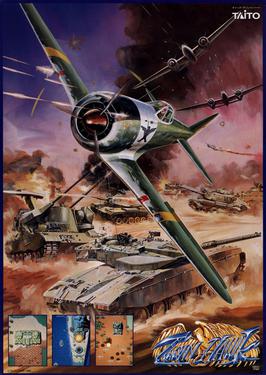
Twin Hawk is a 1989 vertically scrolling shooter arcade video game originally developed by Toaplan and published by Taito. Taking place at the end of an alternative World War II setting, where general Giovanni and his army plots to take over the fictional country Gorongo, players assume the role of a wing commander from the Daisenpū squadron taking control of a Flying Fortress fighter aircraft in an effort to overthrow the enemy.

P-47: The Phantom Fighter is a 1988 horizontally scrolling shooter arcade video game originally developed by NMK and published by Jaleco. Set during World War II, players control a Republic P-47 Thunderbolt fighter aircraft to face against the Nazis, who are occupying multiple countries around the world. Its gameplay involves destroying waves of enemies, picking up power-ups and new weapons, and destroying bosses. It ran on the Mega System 1 hardware.




















